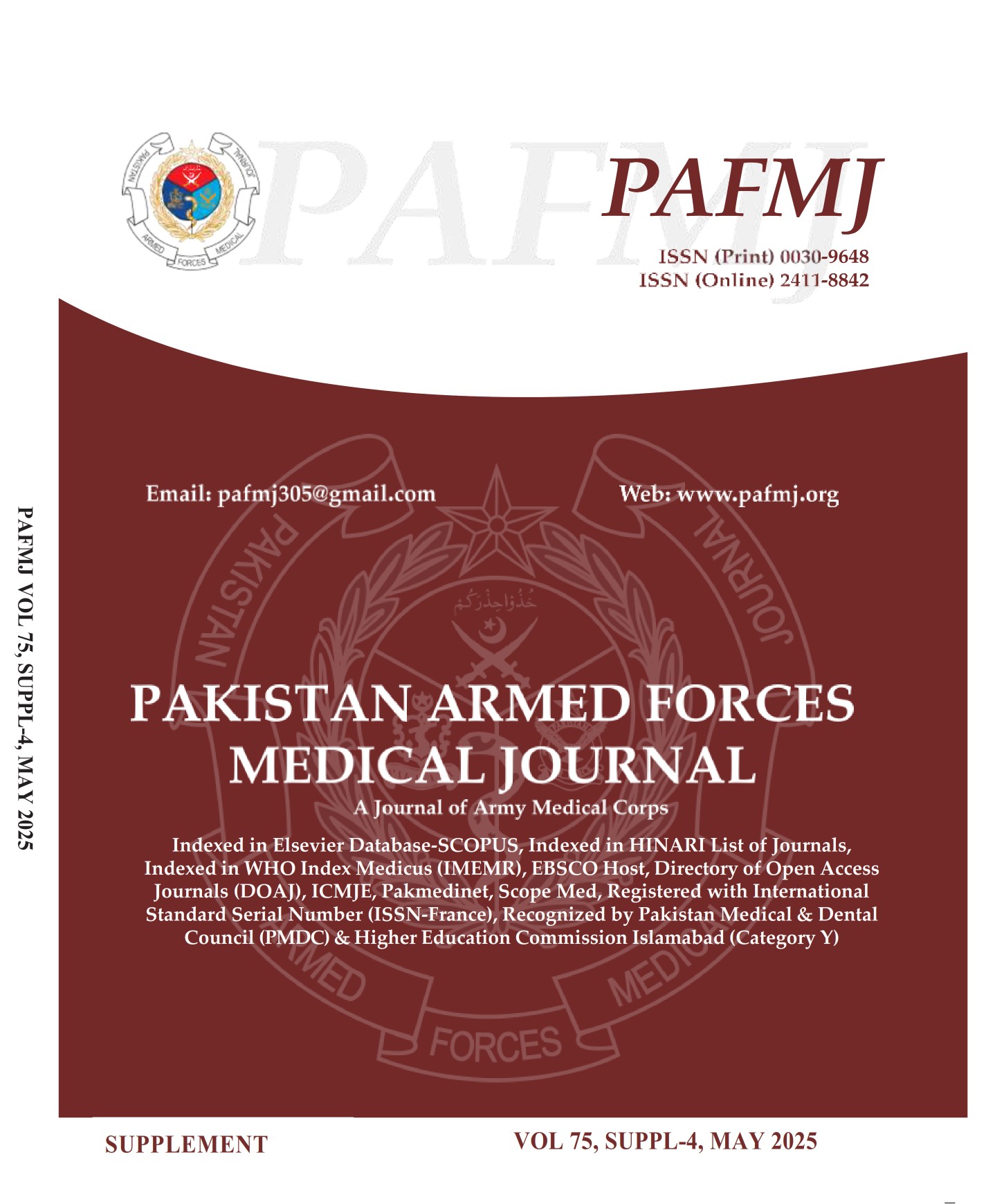Spectrum of Pancytopenia in Local Population
DOI:
https://doi.org/10.51253/pafmj.v75iSUPPL-4.7427Keywords:
Bone marrow aspiration, leukemia, megaloblastic anaemia, pancytopeniaAbstract
Objective: To determine the frequency of pancytopenia aetiologies in local population.
Study Design: Cross sectional study
Place and Duration of Study: Haematology Department, Armed Forces Institute of Pathology, Rawalpindi Pakistan, from Jun 2020 to Jul 2021.
Methodology: A total of 263 patients having pancytopenia were inducted in study from 30 June 2020 to 1 July 2021. All patients having pancytopenia were included in the study and all patients receiving chemotherapy/cytotoxic drug therapy were excluded. Blood complete picture (Blood CP), reticulocyte count, peripheral blood smear, bone marrow aspirate smear and trephine biopsies were done according to standard protocols.
Results: Out of 263 patients diagnosed with pancytopenia, megaloblastic anemia was commonest and present in 25.85% (68 cases) followed by leukemia in 25.09% (66 cases), aplastic anaemia in 14.44% (38 cases), mixed deficiency anaemia 9.50% (25 cases), non-haemopoietic infiltrate/metastasis 7.60% (20 cases), infectious/inflammatory/sepsis 4.56% (12 cases), myelodysplastic syndrome 3.42% (9 cases), lymphoma 3.04% (8 cases), hypersplenism 1.90% (5 cases), granulomatous inflammation 1.52% (4 cases), visceral leishmaniasis 1.14% (3 cases), storage disorders 1.14% (3 cases), histiocytic lymphohistiocytosis 0.80% (2 cases) respectively.
Conclusion: Megaloblastic anaemia is the commonest pancytopenia cause followed by leukemias, aplastic anaemia, mixed deficiency anaemia, non-haemopoietic infiltrate (metastasis), infections/inflammations/septicaemias, lymphomas, visceral leishmaniasis, myelodysplastic syndrome, hypersplenism, granulomatous inflammation, storage disorders and histiocytic lymphohistiocytosis.
Downloads
References
Jain A, Naniwadekar M. An etiological reappraisal of pancytopenia - largest series reported to date from a single tertiary care teaching hospital. BMC Hematol. 2013 Nov 6; 13(1): 1-10.
Ahmad N, Akhter N, Ahmad T. Pancytopenia - A Study on Clinical and Etiological Profile at a Tertiary Care Institute. Int J Sci Stud. 2018; 6(1): 33-36.
Makheja KD, Maheshwari BK, Arain S, Kumar S, Kumari S, Vikash. The common causes leading to pancytopenia in patients presenting to tertiary care hospital. Pak J Med Sci. 2013 Sep; 29(5): 1108-1111.
Azaad M, Li Y, Zhang Q, Wang H. Detection of Pancytopenia Associated with Clinical Manifestation and Their Final Diagnosis. Open Journal of Blood Diseases. 2015 Jul; 5(3): 17-30.
Gayathri BN, Rao KS. Pancytopenia: a clinico hematological study. J Lab Physicians. 2011 Jan-Jun; 3(1): 15-20.
Aziz T, Ali L, Ansari T, Liaquat HB, Shah S, Ara J. Pancytopenia: megaloblastic anemia is still the commonest cause. Pak J Med Sci. 2010 Jan; 26: 132-36.
Hao T, Li-Talley M, Buck A, Chen W. An emerging trend of rapid increase of leukemia but not all cancers in the aging population in the United States. Sci Rep. 2019 Aug 19; 9(1): 12070.
Sung H, Ferlay J, Siegel RL, Laversanne M, Soerjomataram I, Jemal A, Bray F. Global Cancer Statistics 2020: GLOBOCAN Estimates of Incidence and Mortality Worldwide for 36 Cancers in 185 Countries. CA Cancer J Clin. 2021 May; 71(3): 209-249.
Niazi M, Raziq F. The ilncidence of underlying pathology in pancytopenia - an experience of 89 cases. J Postgrad Med Inst. 2004 Sep; 18(1): 76-79.
Memon S, Shaikh S, Nizamani MA. Etiological spectrum of pancytopenia based on bone marrow examination in children. J Coll Physicians Surg Pak. 2008 Mar; 18(3): 163-167.
Jan AZ, Zahid B, Ahmad S, Gul Z. Pancytopenia in children: A 6-year spectrum of patients admitted to Pediatric Department of Rehman Medical Institute, Peshawar. Pak J Med Sci. 2013 Sep; 29(5): 1153-1157.
Raphael V, Khonglah Y, Dey B, Gogoi P, Bhuyan A: Pancytopenia: an etiological profile. Turk J Hematol. 2012 Mar; 29: 80-81.
Yokuş O, Gedik H. Etiological causes of pancytopenia: A report of 137 cases. Avicenna J Med. 2016 Oct-Dec; 6(4): 109-112.
Ishtiaq O, Baqai HZ, Anwer F, Hussain N. Patterns of pancytopenia patients in a general medical ward and a proposed diagnostic approach. J Ayub Med Coll Abbottabad. 2004 Jan-Mar; 16(1): 8-13.
Hamid GA, Shukry SA. Patterns of pancytopenia in Yemen. Turk J Haematol. 2008 Jun 5; 25(2): 71-74.
Devi PM et al. Clinico-hematological profile of pancytopenia in Manipur, India. J Kuwait Med Assoc. 2008 Sep; 40: 221-224.
Tariq M, Khan NU, Basri R, Said A. Aetiology of pancytopenia. Prof Med J 2010 Jun; 17: 252-256.
Hossain MZ et al. The common causes leading to pancytopenia at tertiary care hospital. J Dhaka Med Coll. 2017 Oct; 26(2): 157-161.
Downloads
Published
Issue
Section
License
Copyright (c) 2025 Syeda Samia Shafaat, Asad Mahmood, Hafeez Ud Din, Ali Jamal

This work is licensed under a Creative Commons Attribution-NonCommercial 4.0 International License.















